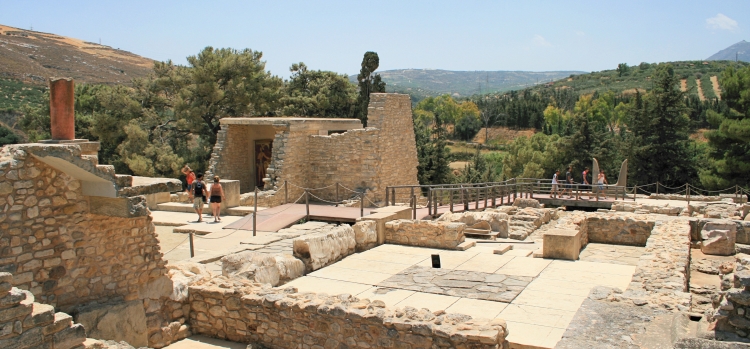Knossos Palace
Knossos is the site of the most important and better known palace of Minoan civilization. According to tradition, it was the seat of the legendary king Minos. The Palace is also connected with thrilling legends, such as the myth of the Labyrinth with the Minotaur, and the story of Daidalos and Icaros. The site was continuously inhabited from the Neolithic period (7000-3000 B.C.) until Roman times. The Linear B tablets (Mycenaean script) of the 14th century B.C. mention the city as ko-no-so.
Intensive habitation occured mostly in the Minoan period, when the so-called first (19th-17th centuries B.C.) and second palaces (16th-14th centuries B.C.) were built along with luxurious houses, a hospice and various other structures. After its partial destruction in 1450 B.C., Knossos was settled by Mycenaeans from the Greek Mainland. The city flourished again during the Hellenistic period (sanctuaries of Glaukos, Demeter, other sanctuaries, chamber tombs, north cemetery, defensive towers) and in 67 B.C. it was captured by the Roman Quintus Caecilius Metelus Creticus. The "Villa of Dionysos", a private house with splendid mosaics was built in the same period
Knossos was discovered in 1878 by Minos Kalokairinos. Arthur Evans conducted systematic excavations at the site between 1900 and 1931, bringing to light the palace, a large section of the Minoan city, and the cemeteries. Since then, the site and the surrounding area have been excavated by the British School of Archaeology at Athens and the 23rd E.P.C.A.
Intensive habitation occured mostly in the Minoan period, when the so-called first (19th-17th centuries B.C.) and second palaces (16th-14th centuries B.C.) were built along with luxurious houses, a hospice and various other structures. After its partial destruction in 1450 B.C., Knossos was settled by Mycenaeans from the Greek Mainland. The city flourished again during the Hellenistic period (sanctuaries of Glaukos, Demeter, other sanctuaries, chamber tombs, north cemetery, defensive towers) and in 67 B.C. it was captured by the Roman Quintus Caecilius Metelus Creticus. The "Villa of Dionysos", a private house with splendid mosaics was built in the same period
Knossos was discovered in 1878 by Minos Kalokairinos. Arthur Evans conducted systematic excavations at the site between 1900 and 1931, bringing to light the palace, a large section of the Minoan city, and the cemeteries. Since then, the site and the surrounding area have been excavated by the British School of Archaeology at Athens and the 23rd E.P.C.A.
The Palace of Knossos. It is the largest of the preserved Minoan palatial centres. Four wings are arranged around a central courtyard, containing the royal quarters, workshops, shrines, storerooms, repositories, the throne room and banquet halls. Dated to 2000-1350 B.C.
The Palace at Knossos is the largest (it covers an area of 20,000 square metres) and most spectacular of all the Minoan palatial centres. It has all the typical features of the architectural type established in ca. 1700 B.C.: four wings arranged around a rectangular, central court, oriented N-S, which is actually the nucleus of the whole complex. The east wing contains the residential quarters, the workshops and a shrine. The west wing is occupied by the storerooms with the large pithoi (storage jars), the shrines, the repositories, the throne room and, on the upper floors, the banquet halls. The north wing contains the so-called "Customs House", a lustral basin and the stone-built theatral area. The South Propylon is the most imposing building in the south wing. A second, paved courtyard to the west of the palace, equipped with the "processional ways" (narrow causeways), was probably used for religious ceremonies. The palace had many storeys, it was built of ashlar blocks and its walls were decorated with splendid frescoes ( 1 , 2) , mostly representing religious ceremonies.
T he Palace at Knossos is the largest (it covers an area of 20,000 square metres) and most spectacular of all the Minoan palatial centres. It has all the typical features of the architectural type established in ca. 1700 B.C.: four wings arranged around a rectangular, central court, oriented N-S, which is actually the nucleus of the whole complex. The east wing contains the residential quarters, the workshops and a shrine. The west wing is occupied by the storerooms with the large pithoi (storage jars), the shrines, the repositories, the throne room and, on the upper floors, the banquet halls. The north wing contains the so-called "Customs House", a lustral basin and the stone-built theatral area. The South Propylon is the most imposing building in the south wing. A second, paved courtyard to the west of the palace, equipped with the "processional ways" (narrow causeways), was probably used for religious ceremonies. The palace had many storeys, it was built of ashlar blocks and its walls were decorated with splendid frescoes ( 1 , 2) , mostly representing religious ceremonies.
The palace had many storeys, it was built of ashlar blocks and its walls were decorated with splendid frescoes, mostly representing religious ceremonies.The palace had many storeys, it was built of ashlar blocks and its walls were decorated with splendid frescoes, mostly representing religious ceremonies.
The palace had many storeys, it was built of ashlar blocks and its walls were decorated with splendid frescoes, mostly representing religious ceremonies.
The old (first) palace was built in around 2000 B.C. but it was completely destroyed by an earthquake in 1700 B.C. The new (second) palace, more complex in plan, strongly resembling a labyrinth, was constructed immediately afterwards. In the middle of the 15th century B.C. the Achaeans from the Greek Mainland conquered the island of Crete and settled at the palace of Knossos. They used the Greek language, as is indicated by the clay tablets they left, written in the Linear B script. The palace was again destroyed by fire in the mid-14th century B.C. (LM IIIA period) and ceased to function as a palatial centre
T he first excavations on the site of Knossos were conducted in 1878 by Minos Kalokairinos, a Cretan merchant and antiquarian, who brought to light part of the magazines in the west wing of the palace and a section of the west facade. After Kalokairinos, several people attempted to continue the excavations: W.J. Stillman, the American Consul in Greece, H. Schliemann, the excavator of Mycenae, together with his collaborator W. Doerpfeld, M. Joubin, a French archaeologist and Arthur Evans, director of the Ashmolean Museum in Oxford.
They all abandoned their efforts, not being able to purchase the land, due to the exaggerated demands of the owners. In 1898, when Crete became an independent state with Prince George as the Governor General, a law was established according which all the antiquities of the island were the property of the state. Thus, in 1900, the systematic excavation of the palace began under the direction of A. Evans. Work was interrupted in 1912-1914 by the Balkan Wars but was resumed in 1922 and continued until 1931, when the investigation of the West Court and the Minoan town was completed.
The Little Palace. It lies to the west of the main palace and has all the features of palatial architecture: scraped wall masonry, reception rooms, a pristyle hall, a double megaron with polythyra (pi er-and-door partitions) and a lustral basin-shrine. Dated to the 17th-15th centuries B.C.
The Little Palace. It lies to the west of the main palace and has all the features of palatial architecture: scraped wall masonry, reception rooms, a pristyle hall, a double megaron with polythyra (pi er-and-door partitions) and a lustral basin-shrine. Dated to the 17th-15th centuries B.C.
The Royal Villa. It lies to the NE of the palace and its architectural form is distinguished by the polythyra, the pillar crypt and the double staircase, with two flights of stairs. It is strongly religious in character and might have been the residence of an aristocrat or a high priest. Dated to the 14th century B.C.
House of the Frescoes. It is located to the NW of the palace and is a small urban mansion with rich decoration on the walls. Dated to the 15th, 14th-12th centuries B.C.
Caravanserai. It lies to the south of the palace and was interpreted as a reception hall and hospice. Some of the rooms are equipped with baths and decorated with wall paintings.
The "Unexplored Mansion". Private building, probably of private-industrial function, to the NW of the palace. It is rectangular, with a central, four-pillared hall, corridors, storerooms and remains of a staircase. Dated to the 14th-12th centuries B.C.
Temple Tomb. It is located almost 600 m. to the south of the palace and was connected with the "House of the High Priest" by means of a paved street. It seems that one of the last kings of Knossos (17th-14th centuries B.C.) was buried here. Typical features of its architecture are the hypostyle, two-pillar crypt, the entrance with the courtyard, the portico and a small anteroom.
House of the High Priest. It lies 300 m. to the south of Caravanserai and contains a stone altar with two columns, framed by the bases of double axes.
The South Mansion. Private civic house, located to the south of the palace. It is a three-storeyed building with a lustral basin and a hypostyle crypt, dating from the 17th-15th centuries B.C.
Villa of Dionysos. Private, peristyle house of the Roman period. It is decorated with splendid mosaics by Apollinarius, depicting Dionysos. The house contains special rooms employed for the Dionysiac cult. Dated to the 2nd century A.D.
The Palace is also connected with thrilling legends, such as the myth of the Labyrinth with the Minotaur, and the story of Daidalos and Icaros.
Teilen Sie den Artikel



